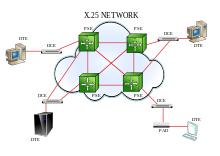| Interface between Data Terminal Equipment (DTE) and Data Circuit-terminating Equipment (DCE) for terminals operating in the packet mode and connected to public data networks by dedicated circuit | |
 | |
| Status | In force |
|---|---|
| Year started | 1976 |
| Latest version | (10/96) October 1996 |
| Organization | ITU-T |
| Committee | Study Group VII |
| Domain | networking |
| Website | https://www.itu.int/rec/T-REC-X.25/ |
X.25 is an ITU-T standard protocol suite for packet-switched data communication in wide area networks (WAN). It was originally defined by the International Telegraph and Telephone Consultative Committee (CCITT, now ITU-T) in a series of drafts and finalized in a publication known as The Orange Book in 1976.[1][2]
The protocol suite is designed as three conceptual layers, which correspond closely to the lower three layers of the seven-layer OSI Reference Model, although it was developed several years before the OSI model (1984).[3][4] It also supports functionality not found in the OSI network layer.[5][6] An X.25 WAN consists of packet-switching exchange (PSE) nodes as the networking hardware, and leased lines, plain old telephone service connections, or ISDN connections as physical links.
X.25 was popular with telecommunications companies for their public data networks from the late 1970s to 1990s, which provided worldwide coverage. It was also used in financial transaction systems, such as automated teller machines, and by the credit card payment industry.[7] However, most users have since moved to the Internet Protocol Suite (TCP/IP). X.25 is still used, for example by the aviation industry.[citation needed]
- ^ CCITT, Study Group VII, Draft Recommendation X-25, March 1976
- ^ History of X.25, CCITT Plenary Assemblies and Book Colors
- ^ (Friend et al. 1988, p. 242)
- ^ (Friend et al. 1988, p. 243)
- ^ ITU-T Recommendation X.28.
- ^ ITU-T Recommendation X.3.
- ^ Foregenix (February 2012). "X.25 within the Payment Card Industry" (PDF). Archived from the original (PDF) on 4 March 2016. Retrieved 25 May 2016.